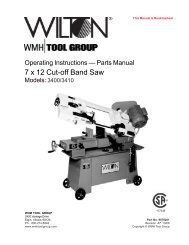Caution: This document contains mixed page sizes ... - Igor Chudov
Caution: This document contains mixed page sizes ... - Igor Chudov
Caution: This document contains mixed page sizes ... - Igor Chudov
Create successful ePaper yourself
Turn your PDF publications into a flip-book with our unique Google optimized e-Paper software.
GENERAL<br />
All of the following Adjustments and Tests can be<br />
performed, without disassembly of the generator.<br />
They should be used for testing generator and regu-<br />
lator components in conjunction with the trouble-<br />
shooting flow charts.<br />
. .<br />
VOLTAGE CALIBRATION ADJUSTMENT<br />
Thecalibration adjustmentis made using an accurate<br />
AC voltmeter to observe generator output voltage<br />
and to set the correct no load voltage. If voltage regu-<br />
lator VR21 printed circuit board has been replaced, it<br />
may be necessary to make a calibration adjustment.<br />
To obtain the correct output voltage, proceed as<br />
follows:<br />
1. If set hasavoltageadjust potentiometer (R22) on<br />
the meter panel, set pointer halfway between min-<br />
imum and maximum positions.<br />
2. With unit running at no load, turn generator vol-<br />
tage potentiometer R26on VR21 (Figure 5) clock-<br />
wise to increase output voltage; turn R26 coun-<br />
terclockwise to decrease output voltage.<br />
VOLTAGE STABILITY ADJUSTMENT<br />
Voltage stability is set at the factory, but if printed<br />
circuit board VR21 has been replaced or if damping<br />
potentiometer R27 has been unnecessarily adjusted<br />
it may be necessary to reset stability. Set stability as<br />
follows:<br />
1. With generatorset running at no load, turn poten-<br />
tiometer R27 (Figure 5) to a position where vol-<br />
tage tends to be unstable or hunt.<br />
2. Turn R27 clockwise slowly until voltage first sta-<br />
bilizes. <strong>This</strong> setting will result in stable voltage<br />
under all conditions in maximum voltage regula-<br />
tor response time.<br />
BATTERY CHARGE RATE ADJUSTMENT<br />
One generator winding supplies current for the bat-<br />
tery charging circuit. The current flows through<br />
ADJUSTMENTS AND TESTS<br />
(STANDARD YD GENERATOR AND REGULATOR)<br />
I<br />
10<br />
diode CRl1, ammeter M11, to the battery, and to the<br />
ignition-fuel solenoid circuits.<br />
1. The slide tap on adjustable resistor R21, located<br />
in the generator air outlet, should be set to give<br />
about 2 amperes charging rate, Figure 2. For<br />
applications requiring frequent starts, check battery<br />
charge condition (specific gravity) periodically<br />
and if necessary, increase charging rate<br />
slightly (slide tap nearer ungrounded lead) until it<br />
keeps battery charged: Having engine stopped<br />
when readjusting avoids accidental shorts. Avoid<br />
overcharging. .<br />
2. If charge winding AC output is below: .<br />
a. 19 volts on 12 volt battery charge models,<br />
b. 38 volts on 24 volt battery charge models,<br />
c. 50 volts on 32 volt battery charge models,<br />
test the charging circuit for opens or grounds in<br />
the leads and charging winding. If leads are<br />
defective, replace them. If winding is defective,.<br />
replace generator stator.<br />
3. If a separate automatic demand control for starting<br />
and stopping is used, adjust charge rate for<br />
maximum 4.5 amperes. <strong>This</strong> normally keeps battery<br />
charged even if starts occur as often as 15<br />
minutes apart.<br />
VOLTAGE REGULATOR CHECKOUT<br />
The solid state voltage regulators (VR21) can be<br />
checked out on the bench for proper operation or<br />
location of faulty components. The following test<br />
equipment (one-each) is required fora proper check-<br />
out.<br />
REF. DESIGNATION TEST EQUIPMENT<br />
S ........................................ Switch<br />
CMR21 .................................. Reactor<br />
F.. ................................. Fuse, 5 Amps<br />
T1 ........... Transformer, Variable 2 Amp 0-15OV<br />
V2 ............ Voltmeter, .DC f 2% of Full Scale 3,<br />
...<br />
Scale Q.50 and 0-15OV and 0-1OV<br />
V1 ..... Voltmeter, AC f 2% @ lOVAC, 1% @ 150V<br />
R1 ..................... .Resistor, 100-Ohm 400 W<br />
T21 ................. .Transformer, Input 315-0386<br />
Transformer T21 and reactor CMR21 are a part of the<br />
voltage regulatorassembly (VR22orVR23); theseare<br />
the only parts obtainable with an Onan part number.<br />
The big 100-ohm 400 watt resistor (Rl) serves as the<br />
field during checkout.
















